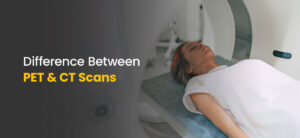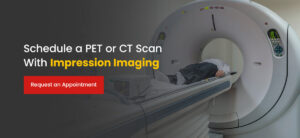
Difference Between PET & CT Scans
A positron emission tomography (PET) scan and computed tomography(CT) scan are imaging techniques to detect medical abnormalities and diagnose a disease or medical condition. Medical professionals use PET and CT scans to gather detailed information to diagnose underlying medical conditions. Learn the difference between a PET scan and a CT scan and their varied applications.
What Is the Difference Between a PET Scan and CT Scan?
The difference between a CT scan and a PET scan is their applications and what each test can diagnose. Both CT and PET scans are useful diagnostic tools that provide detailed, clear views of the body and internal structures. While PET and CT scans are similar in some ways, they are two different types of imaging used for certain procedures or tests.
On a general level, the main difference between CT and PET scans is their overall focus. CT scans create an accurate, non-moving image of the body’s tissues, bones and organs. On the other hand, a PET scan provides medical professionals with an in-depth look into how the body’s tissues operate on a cellular level. Other differences between a CT scan and a PET scan include:
- Time: In general, PET scans are often more time-consuming. While a medical professional can perform a CT scan in a few minutes, they will need more time to complete a PET scan. Because of this time, medical professionals often use CT scans in emergency settings where they need to assess a patient’s health quickly. A PET scan can take anywhere from 20 minutes to several hours to complete, depending on the testing needed. Although not as common, a PET scan can even be performed over several days if needed.
- Radiation: Another distinction between PET and CT scans is that radiation doesn’t remain in the body with a CT scan. Following a CT scan, no radiation remains in the body, which is not the case with PET scans. Following a PET scan, a small amount of radiation remains within the body for a short period.
- Materials: PET and CT scans also use different materials. For example, CT scans use X-rays to create images of the body. Pet scans utilize a radioactive material to emit energy, which a specialized camera detects to develop clear, precise images.
- Detection: PET scans are often more efficient at detecting cancer earlier than other tests. A PET scan provides medical professionals with an in-depth view of molecular activity, helping identify cancer and other health conditions in their earliest stages. Although CT scans are an effective diagnostic tool, they often only show signs of a medical condition after a disease changes the organ or tissue’s structure.

What Is Similar About PET and CT Scans?
PET and CT scans are imaging tests that focus on various parts of the body to provide medical professionals with additional information. Both scans are often performed in outpatient facilities and don’t require a hospital stay unless the underlying medical condition detected with these tests needs further monitoring.
Although both PET and CT scans can detect cancer, a PET scan may detect cancer earlier than a CT scan. CT scans and PET scans are noninvasive, painless and effective procedures that can minimize unnecessary exploratory surgery or testing. One of the most important similarities of these scans is they can help physicians understand a patient’s health and diagnose a medical condition.
CT and PET scans may be used along with other procedures, including magnetic resonance imaging (MRI) and X-rays, to diagnose a medical condition accurately. A physician can use the findings from PET and CT scans to create an effective treatment plan.
CT scans are often used for acute conditions and injuries or chronic vascular conditions. CT scans are a valuable tool for helping physicians determine the location and size of a tumor and guiding medical procedures to treat tumors.
A medical provider may use a PET scan to diagnose cancer and develop a proper treatment plan. PET scans may help physicians create a heart disease treatment plan because they show vascular issues that decrease blood flow to the heart. In some cases, a physician can also use a PET scan to detect and diagnose various brain disorders, including brain tumors, dementia, Alzheimer’s disease and seizures.
Why Would a Doctor Recommend PET or CT Scans?
PET and CT scans are versatile imaging tools to assess and diagnose various medical conditions. While both scans may detect similar conditions, each has unique benefits and are more efficient at diagnosing certain diseases. Learn more about PET and CT scan applications:
PET Scan Applications
Physicians often use PET scans to assess the health of a patient’s organs and tissues to diagnose a disease or other medical condition. A physician may recommend a PET scan to evaluate the health and function of various organs, including the brain and heart. PET scans are helpful in diagnosing cancer and evaluating the effectiveness of cancer treatments, and they may also help diagnose:
- Epilepsy
- Hematoma
- Brain trauma
- Lung lesions
- Stroke
PET scans are also a common diagnostic tool medical teams use to diagnose other serious conditions, like:
- Parkinson’s disease: A physician may also recommend a PET scan to help diagnose Parkinson’s disease, a progressive nervous system disease that may cause a peculiar walking pattern, muscle weakness and fine tremors. Research suggests almost one million people in the United States live with Parkinson’s disease.
- Huntington’s disease: A PET scan can help diagnose Huntington’s disease by detecting and assessing brain abnormalities. Huntington’s disease more commonly affects people of European ancestry, developing in three to seven per every 100,000 people.
CT Scan Applications
A CT scan is a versatile diagnostic tool, allowing medical professionals to detect and diagnose joint and bone problems, including tumors and complex fractures. A CT scan can help medical professionals assess and detect heart disease, tumors, liver masses and emphysema.
A physician may also use CT scans to track changes in an existing medical condition. CT scans can show internal bleeding and injuries from trauma, such as a car accident. In addition to its diagnostic purposes, a CT scan can help guide medical procedures, including radiation therapy, surgeries and biopsies.
Schedule a PET or CT Scan With Impression Imaging
At Impression Imaging, we pride ourselves on offering our patients the highest level of care with convenient services in a compassionate atmosphere. We combine radiology expertise with state-of-the-art equipment to detect and diagnose medical conditions.
In addition to CT and PET scans, we are proud to offer computed tomography angiography (CAT) scans. We also provide cardiac studies, nuclear medicine and oncology imaging. Our team of experts helps ensure your comfort and will answer any questions you have about your imaging procedure.
Contact us online to schedule a CT or PET scan at Impression Imaging.



